I am proud to present the first image in Gods and Heroes of the Aegean, a new series about Greek mythology by Distant Era, featuring actor/intimacy director and coordinator/aerial acrobat/(and more!) Sarah Scanlon as Pandora.
- This series uses techniques learned from a mentorship with photographer Chris Koeppen of An Aethereal Fire.
- A summary of the God and Heroes of the Aegean series goals and inspirations can be found here.
Pandora
And what were they, these shapes? They were mutant descendants of the dark and evil children of both Nyx and Erebus. They were born of Apate, Deceit; Geras, Old Age; Oizys, Misery; Momos, Blame; Keres, Violent Death. They were the offshoots of Ate, Ruin; and Eris, Discord. These were their names: PONOS, Hardship; LIMOS, Starvation; ALGOS, Pain; DYSNOMIA, Anarchy; PSEUDEA, Lies; NEIKEA, Quarrels; AMPHILOGIAI, Disputes; MAKHAI, Wars; HYSMINAI, Battles; ANDROKTASIAI and PHONOI, Manslaughters and Murders.
Illness, Violence, Deceit, Misery, and Want had arrived. They would never leave the earth.
What Pandora did not know was that, when she shut the lid of the jar so hastily, she forever imprisoned inside one last daughter of Nyx. One last little creature was left behind to beat its wings hopelessly in the jar forever. Its name was ELPIS, Hope.
Fry, Stephen. Mythos: (Ancient Greek Mythology Book for Adults, Modern Telling of Classical Greek Myths Book) (Stephen Fry’s Greek Myths 1).
The world’s first human woman, her name means “All-Gifted,” for each of the gods endowed her with many gifts. What does she mean to you?
I’ve mentioned before that Sarah Scanlon is a colossal talent. Working on this image over the course of a year, her expression broke my heart every time. When I look at this image, I see Pandora reaching out as if she’s trying to pull back the flood of evils working its way inevitably into the world. For me, Pandora’s expression is a mixture of awe and regret. The box is open. Already, monstrous, demonic evils swell above and around her, and they course above the waters. There’s nothing anyone can do now. It’s too late. Too late.
There’s one place she isn’t looking. She isn’t looking at the box itself, within which a single faint, bright star glows. She can’t see it. She’s throwing her arm up in vain, eyes fixed on what she’s done, on all the bad that’s bound to happen.
That’s me most days. Maybe it’s a lot of us.
Anyone couldn’t have done this. What we’re looking at in this image isn’t posing—it’s acting. And Sarah Scanlon is an experienced professional actor who gave it her all in this session, playing a range of moments, dramatic and sublime. I am privileged to know so many wonderful actors who’ve dedicated their lives to their craft. Working with them makes these images better and makes me better at making them.
On a sentimental/historical note, Sarah was in the first gig I ever photographed for someone else, back in 2010. That was Jennifer L. Mickelson‘s play The Last Daughter of Oedipus for Babes With Blades Theatre Company, in which she played Antigone. It seems we’ve been making images of the Greeks together since ancient times.
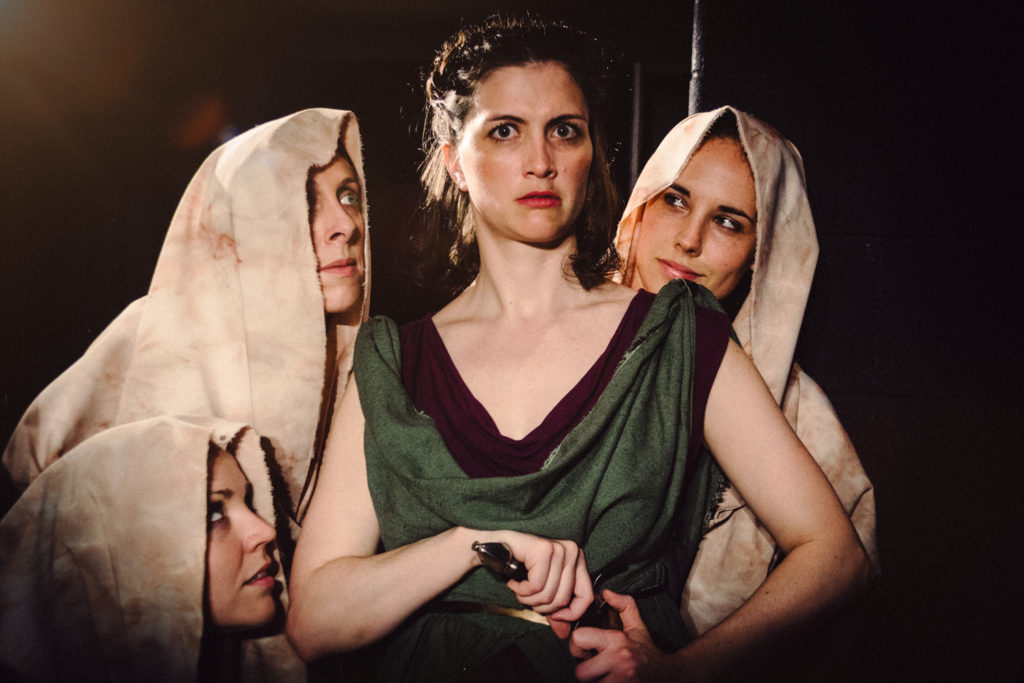
Visualizing the Story
While we photographed Sarah, we imagined the evils escaping off somewhere into the sky, and we photographed several different variations.
Things really got cooking when Quinn Leary started throwing fabric. I’ve mentioned elsewhere that Sarah Scanlon is a consummate actor. Her expressions ranged from the sublime to the dramatic.
For most of the photographs, Pandora carries a box. Thanks to Erasmus’s sixteenth-century mistranslation, “Pandora’s box” has become the way we understand the myth. In the original myth, however, Pandora has a pithos, which is a kind of jar (rather than a “pythis,” a box). Prior to the project, I searched for a pithos online and found several options. All of these options were expensive, and I was uncertain whether they’d work. If Sarah had to miss the shoot for any reason, I’d be left with an expensive prop. I’d already purchased a Greek helmet we didn’t use. Besides, we had a box that would work. Since most people associate Pandora with a box, the storytelling would likely be clearer if we used a box.
AND YET, for authenticity’s sake I decided to shoot a few images with some “items” we have in our place. Scare quotes because I don’t actually know what these are. We shot Pandora holding one of these and then another image of her holding the same object swaddled in black cloth. The idea was that if necessary we could try transforming these or replacing them with a pithos in the compositing stage.
In the end, the image I selected was the one that I thought had the best expression, the best motion, and would be the easiest to composite. In fact, I thought this was going to be pretty easy and straightforward. How young and naive I was!
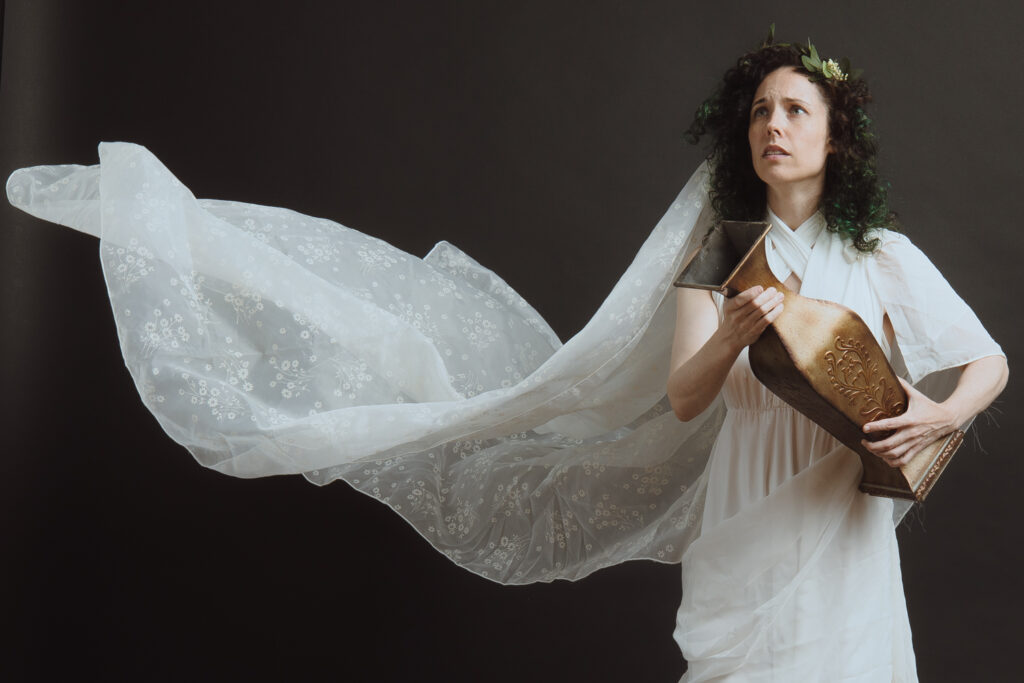
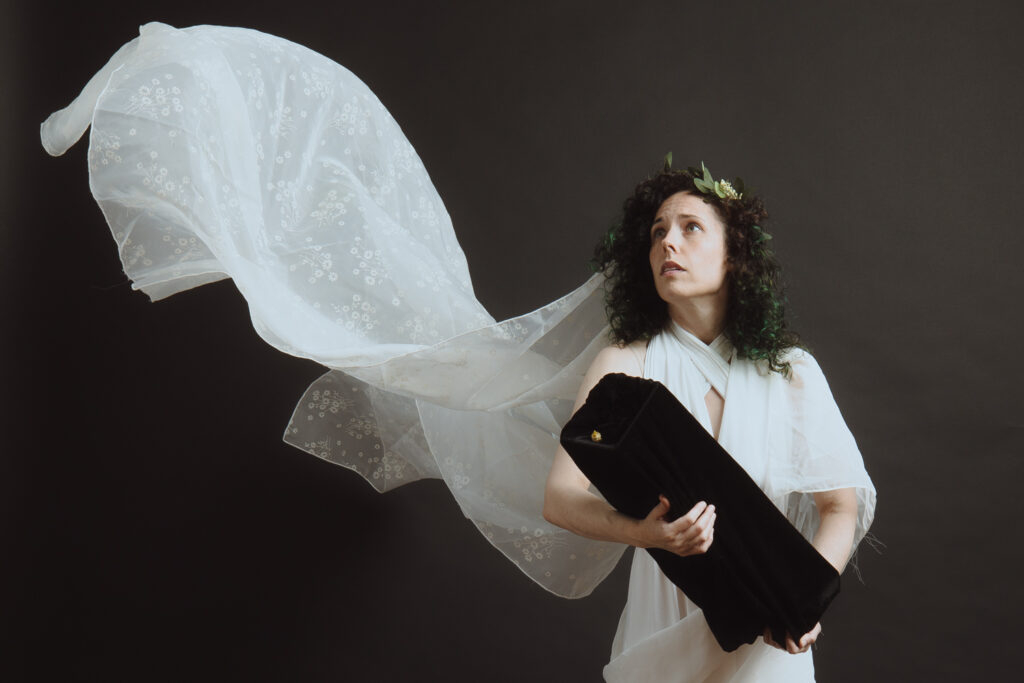
For Authenticity’s Sake
As I struggle with this series, I notice that most of the major snags come from something in the storytelling—something I’m unable to visualize in the compositing stage. This is an ongoing challenge. With Pandora, there was a period of time where the light didn’t work. At first, I’d visualized the evils of the box turning toward Pandora so that they met eye-to-eye. The trouble with that is: if the light is directed towards Pandora, whatever faces her is potentially blocking the light, or backlit. The light needs to work logically or the piece doesn’t gel.
Also, what’s coming out of the box? There was a time I considered representing each of the evils Stephen Fry named in the excerpt above. That was too big a task for me, so then I tried to personify illness, violence, deceit, misery, and want. The more I attempted this, the more complicated the composition became, and the larger the file size. At one point, the image was 33 gb, and every new action slowed my process to an eternally spinning rainbow wheel on my computer screen. Eventually, I chose to simplify the demons, making them a bit more abstract but no less ominous.
This is the thought process that slows down the work, however. I want to present the myth so that it’s recognizable to someone who knows it, but I need to balance and compromise, using the resources at my disposal, as well as the limits of my skill.
Photography
While this section often takes up the bulk of many Distant Era posts, I don’t think it will for Gods and Heroes of the Aegean. For starters, the light is very simple: it’s a single big, diffused umbrella to the right of camera, with two big white V-flats on either side and a black background. That’s it.
The Session
I neglected to mention the session in my introduction to the series. Gods and Heroes of the Aegean was a two-day event in which we photographed thirteen subjects. We did a test the week before, however, where we photographed two additional subjects who’d booked a Distant Era session and got to be test subjects for the series.
I must mention that our mythology expert Quinn Leary was a godsend both days of the session. Though he hardly knew many of the subjects, he made everyone comfortable, helped dress them, and threw fabric like a champ.
Costuming and Props
For costuming, we had some options. Sarah brought a dress, and our costumer Jennifer Mohr had created a peplos for us to use in the series. We thought Pandora should have a kind of radiance to her—something almost immortal. Subjects were rotating in all day, so we didn’t have tons of time to consider.
But then Distant Era MVP Elizabeth MacDougald volunteered to lend a white dress that she thought might fit Sarah. Sarah tried it on, and it fit perfectly. (It’s interesting how many random objects in our place end up as props or costume pieces.) Then our mythology expert Quinn Leary used two lengths of fabric contributed by Jennifer Mohr to create the Pandora’s himation and her veil. Quinn then crowned Pandora with a laurel crown that he had brought for the series. Finally, the box belonged to Sarah Scanlon as well.
This is all just to say that creating Pandora’s look was truly a team effort. Without Jen’s fabric, Elizabeth’s dress, Quinn’s laurel crown and dressing and fabric-throwing skills, and without Sarah’s emotionally grounded performance and prop box, this image would not have been. I am grateful to all of them, and to Erin Gallagher, who also designed and consulted on this series, for their considerable talent.
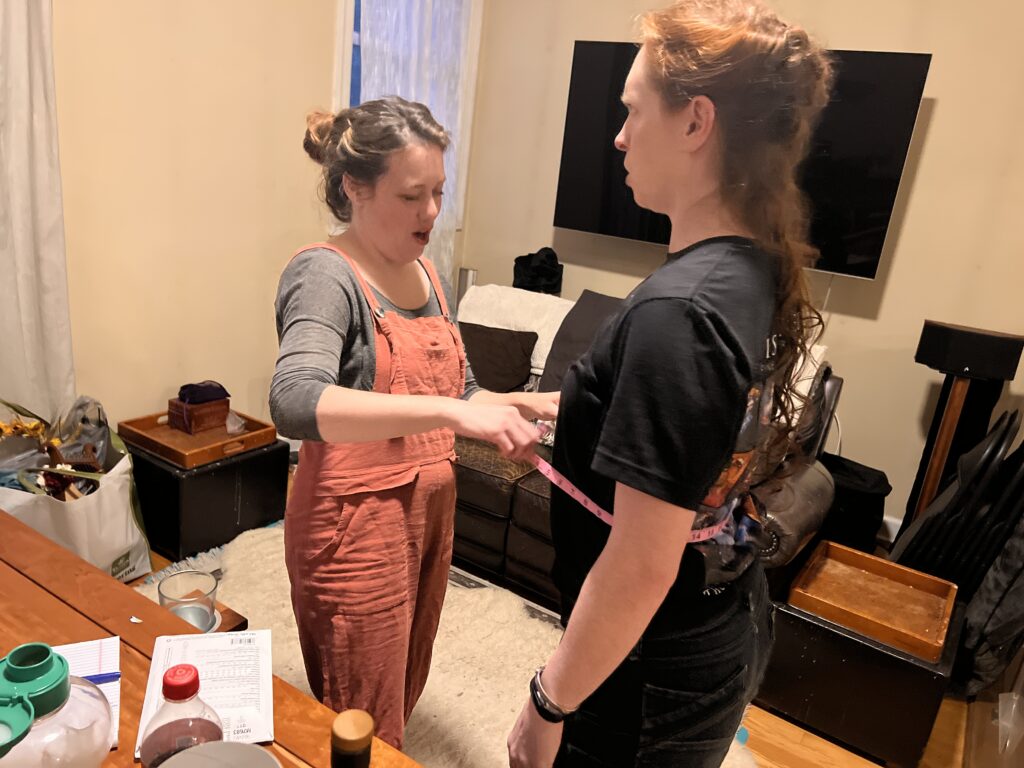
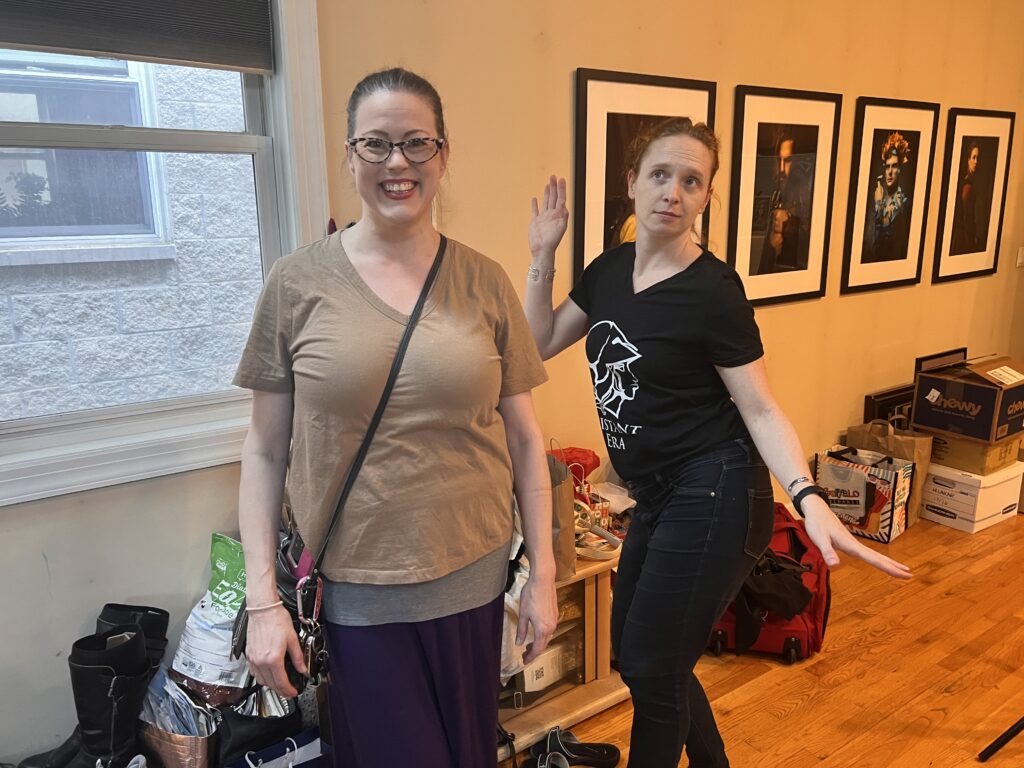
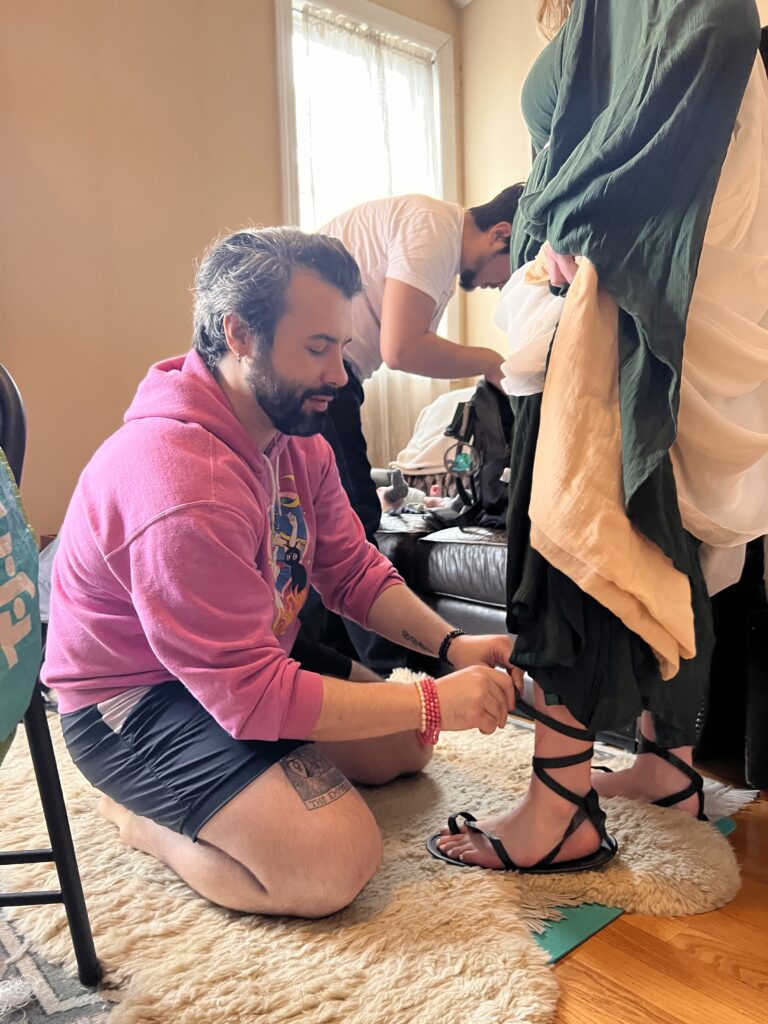
The Edit
Like the photography session, editing of the photo itself was extremely light in comparison to my usual process. I removed a strap on Pandora’s shoulder, took the green dye out of her hair, toned down the brightness of the himation, and that was about it. The composite was another story, however.
The Mask
Even before editing cleanup, in early summer 2023, I tried my hand at extracting Pandora from the background using the techniques I’d learned from Chris Koeppen. I chose Pandora as the first image because she was dressed in white against a black background, which suggested she’d be pretty straightforward. After completing the mask, I placed her against a random background.The veil retained its transparency, showing through to the background beneath it. Success! Almost looks ready to go, doesn’t it? This goes to show that the storytelling was the hardest part.
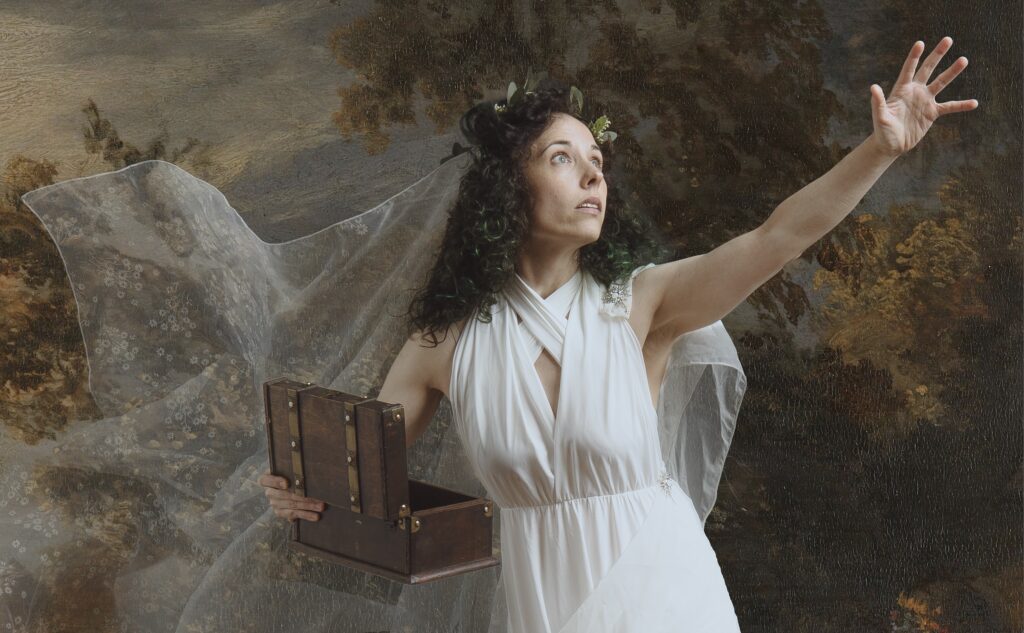
Planning the Image
The first thing I did when I started on Pandora was to visualize where the elements might go and what elements might be in the image. I started by situating Pandora on the lower left side of the image, right on the vertices that split the frame into thirds. Here, I diverted from what my mentor Chris said usually worked best for him. I’d pay for that decision later, but it still seemed like a good idea in the early stages.
I drew in potential smoke billows and monsters and traced Pandora’s eye line to the escaping evils. I labeled the places where I thought I’d have greenery on one side of the image and ruin on the other. In my initial idea, Pandora would stand in the bright, beautiful countryside on the left side of the image, and the place where the evils unfurled on the right would be dark, twisted, and barren. It seemed like a great concept, and I thought I could execute it without a problem.
Boy, was I ever wrong.
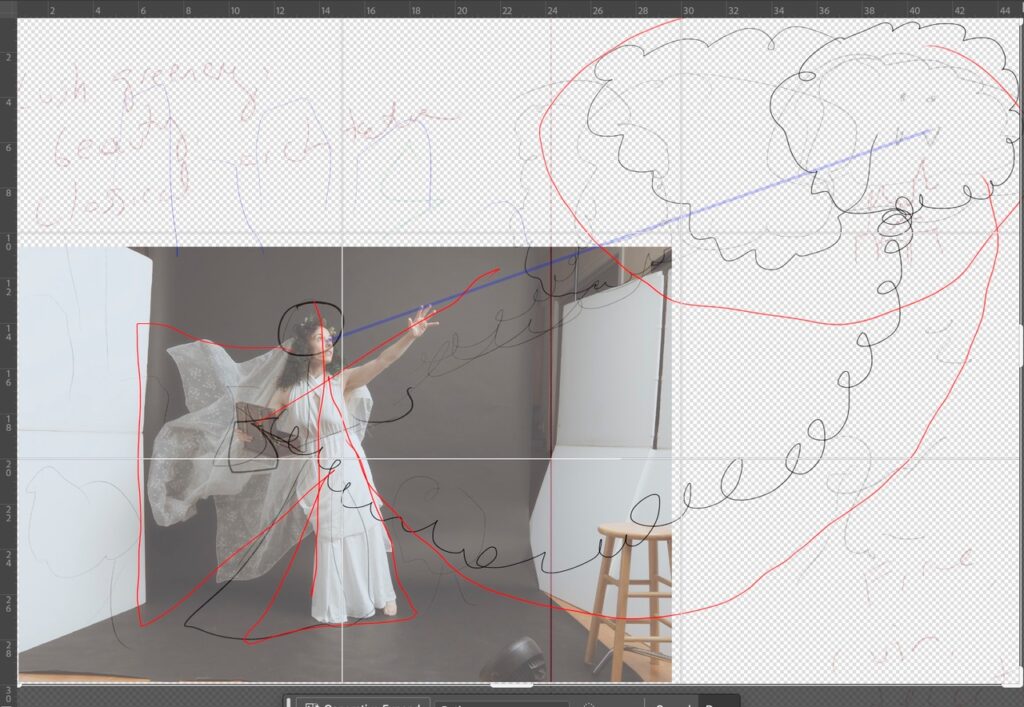
Placing Pandora against a bright background killed the beautiful transparency of her windswept veil. Putting monsters in the sky exactly where my light was caused a logical problem in the image. How’s the light reaching her if the light is covered by clouds of demons? Swirling the smoke in a sweeping arc below her made no sense. I tried many things to make this work, but I didn’t like any of them.
The solution came one day when I discovered a work by the nineteenth-century American painter, Thomas Cole. That painting carried the mood of the image and became one of the core unifying elements of the composite. What’s more, I became a huge fan of Thomas Cole’s work.
Artistic Synthesis and Inspiration
Among the many elements composited in this image are seven different classical paintings and a photograph courtesy of NASA. I hand-painted light, stars, grass, hair, and other minor elements.
Thomas Cole
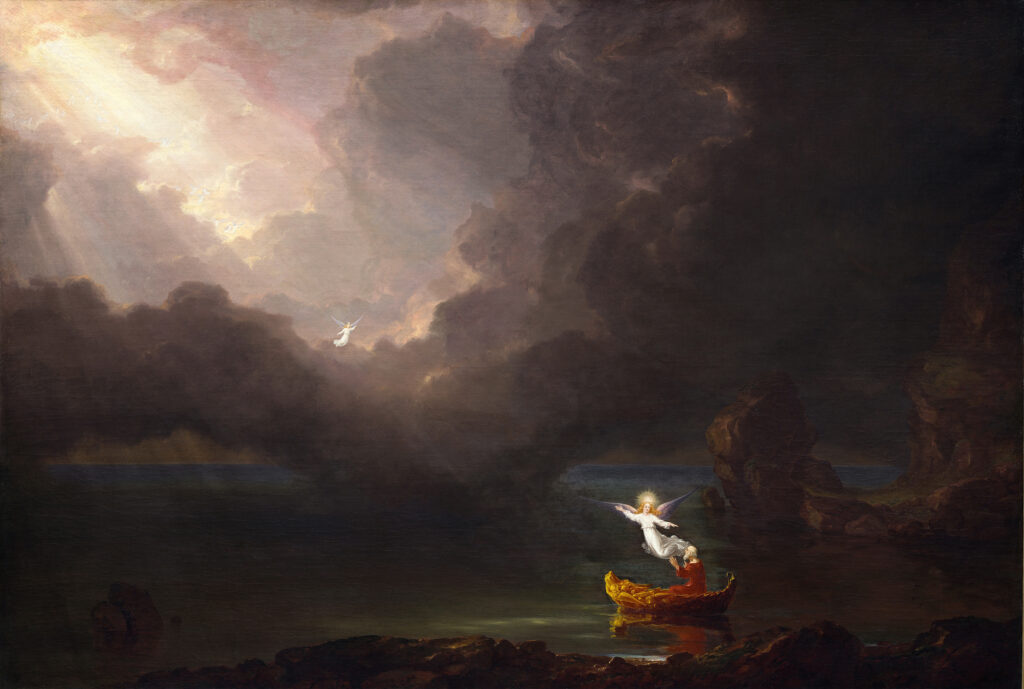
The most prominent piece in this composite comes from American painter Thomas Cole‘s 1848 series, The Voyage of Life. I mentioned in the introduction to this series that my primary inspiration was Edmund Blair Leighton. While that remains true, in drawing from the classics, I’ve become a fan of so many other nineteenth-century painters, particularly Cole who, like Leighton, painted the kinds of fantastical things I care about. I thought the light and clouds might evoke the mood we’d imagined for Pandora.
A Box of Hope
I wanted to show the glimmer of hope in the box. I painted in hope’s glimmer and the light it cast manually. Since I’d given the demon clouds a red cast, I chose to paint hope a cool cyan-blue in contrast.
A Cloud of Demons
As for what’s coming out of the box, what’s coming out of the box is the metaphor.
Everyone’s going to have a different take on what the piece means to them, and the piece will affect everyone in a different way.
I deliberately chose, cut out, warped, shaped, and overpainted the elements in the composite, and though this be madness, yet there is method in’t.
But meaning is for the viewer to decide, so I’ll say no more about it.
Witch Head Nebula
I initially had trouble finding a way to make the demonic smoke cloud billow out of the box. The answer was this image of the Witch Head Nebula, courtesy of NASA.
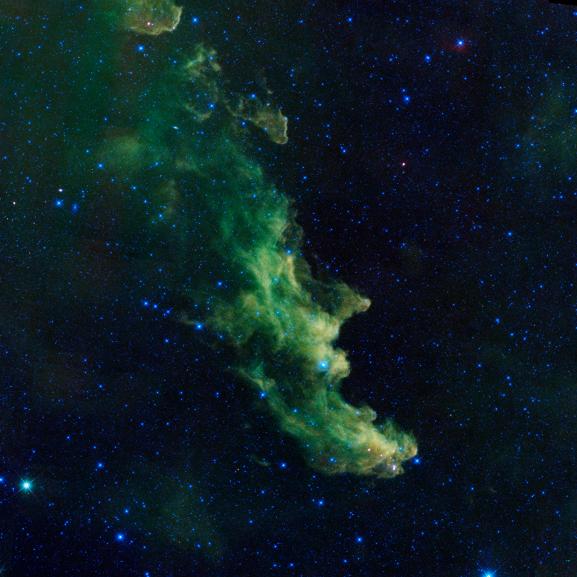
A witch appears to be screaming out into space in this image from NASA’s Wide-Field Infrared Survey Explorer, or WISE. The infrared portrait shows the Witch Head nebula, named after its resemblance to the profile of a wicked witch. Astronomers say the billowy clouds of the nebula, where baby stars are brewing, are being lit up by massive stars. Dust in the cloud is being hit with starlight, causing it to glow with infrared light, which was picked up by WISE’s detectors.
Original caption of image released with NASA’s Wide-Field Infrared Survey Explorer (WISE)
I was also attracted to the idea that what’s unfurling from the box is this stardust, this eternity, this place where stars are born is the origin of all things—of the vast evils streaming from the box but also that single blue star of hope that still shines within it.
In addition to the stars in the nebula, I hand-painted some of my own.
Lightbringing
The light in the original photograph was as simple as can be, far simpler than the light I do for any of my portraits. The idea was to use a source that could act like sunlight.
The light in the final image wasn’t simple. First, there was the matter of including both the light source and the cloud of darkness in the same direction, a puzzle that took a while to figure out. Then there was the matter of the box and the light of hope inside. That light wasn’t present in the original photograph, so I needed to draw it in.
I received a great deal of guidance from Chris Koeppen as I sent various drafts of the image over time. He has a thorough knowledge of the way light works, the way it works in art, and how to illuminate objects convincingly.
On one draft, he pointed out how the box would block the light within it, so those obstructed areas needed to be darker. Near the end of the work, Chris helped me see where the eye traveled in the image and the problems of contrast or lack of contrast that prevented the viewer’s eye from locking on the subject.
It’s fitting that he named his mentorship program Light Bringer, as that’s very much what he does!
Chris also helped me identify issues of scale in the image. Once I’d found light that matched my objective in that Thomas Cole painting, I was scared to mess with it. But as you can see, the figures in the original work are tiny, so my image was out of scale… until I combined it with elements from about five other classical paintings, which put Pandora on a stormy coast and motivated the veil flying out behind her.

And Furthermore…
Sarah Scanlon and I have come a long way since shooting my first gig in 2010, first attempts at storytelling through compositing in 2019, and this first image from Gods and Heroes of the Aegean in 2024. I’m grateful for her friendship and patience as I’ve continued to learn.

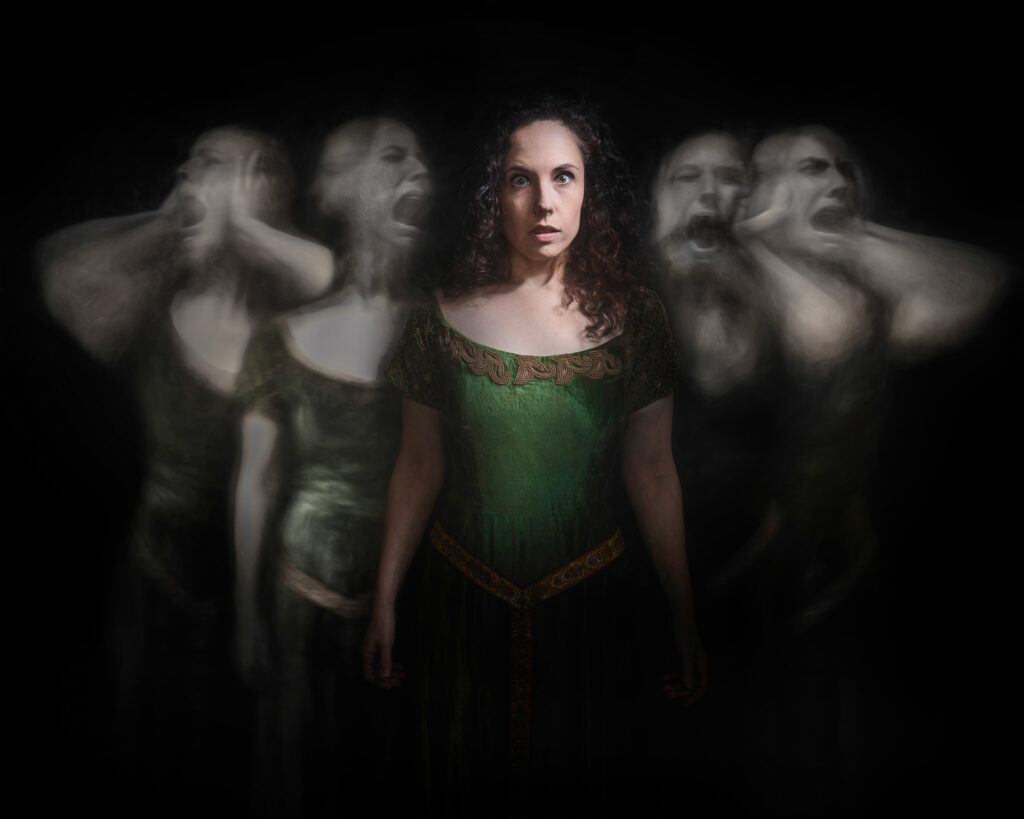

And thus, with great gratitude to Sarah Scanlon, Jennifer Mohr, Quinn Leary, Erin Gallagher, and Chris Koeppen for their advice and contributions to this image, we begin Gods and Heroes of the Aegean series with Pandora. I look forward to completing others from our 2023 session in the coming months!
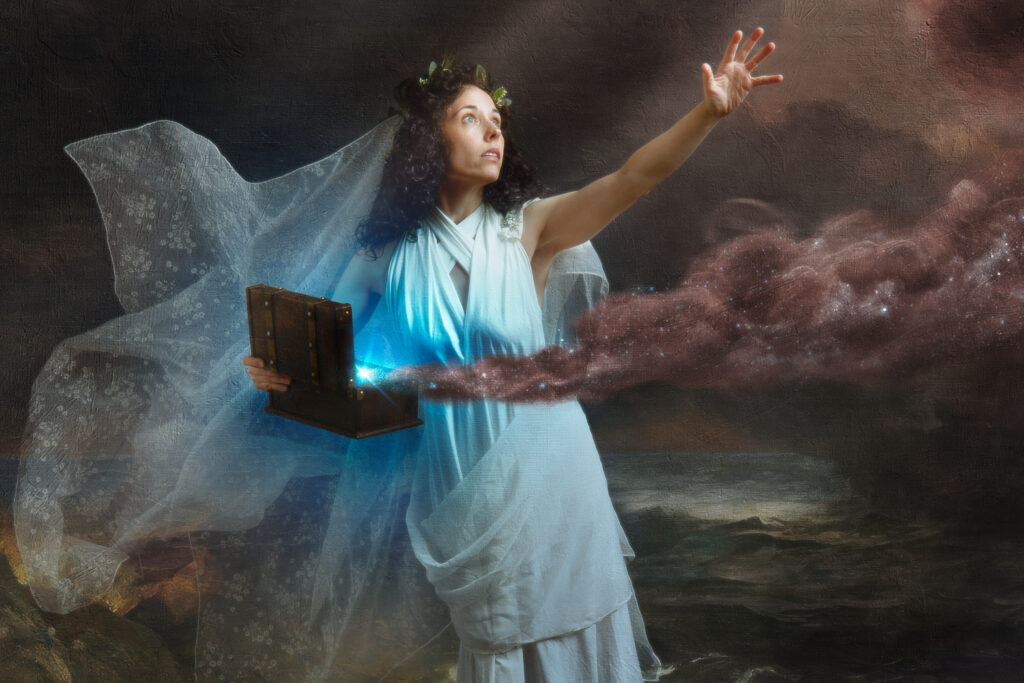

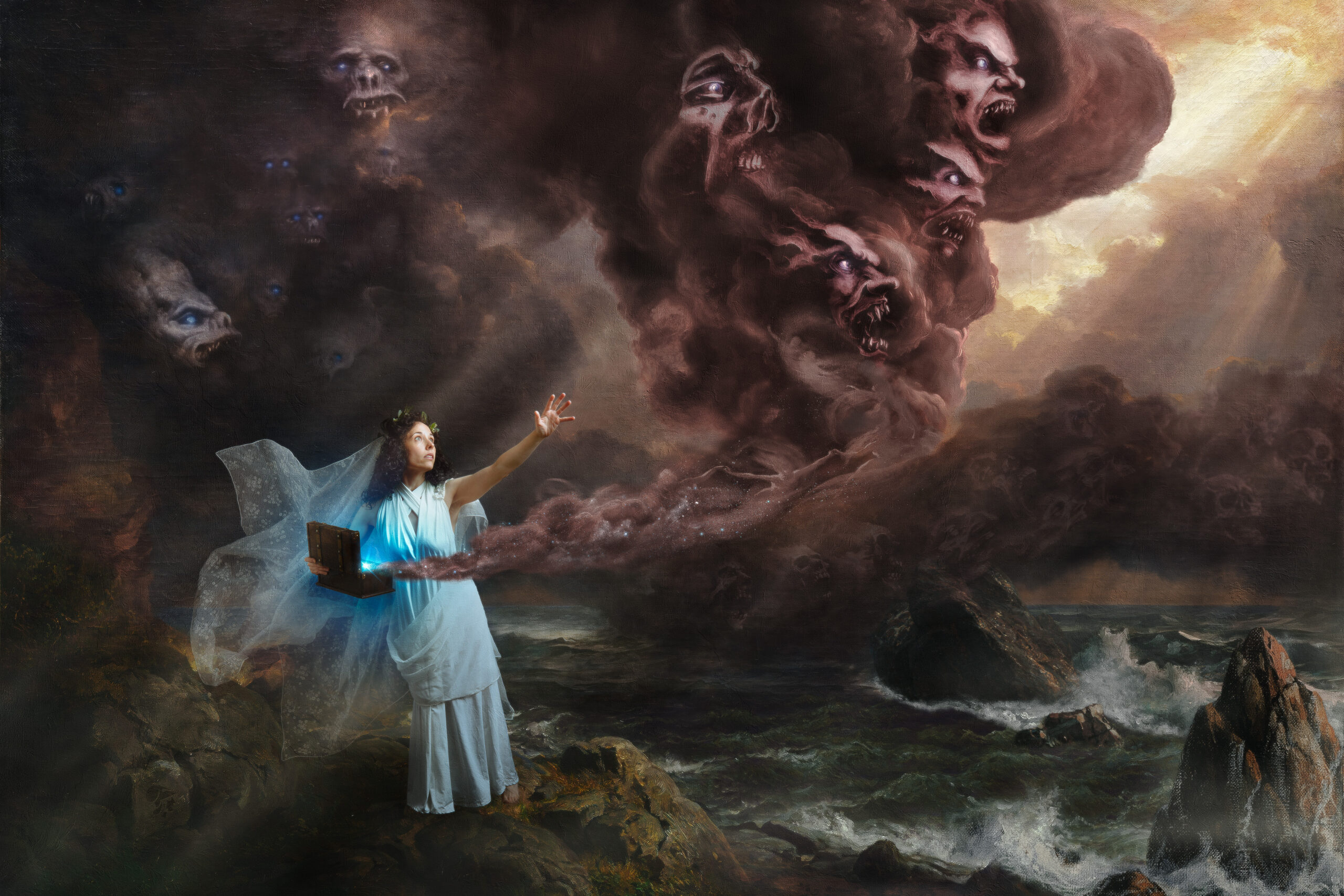
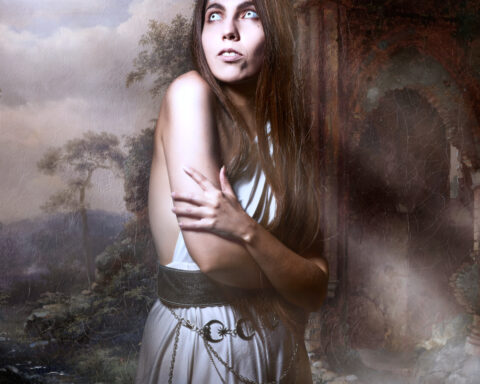
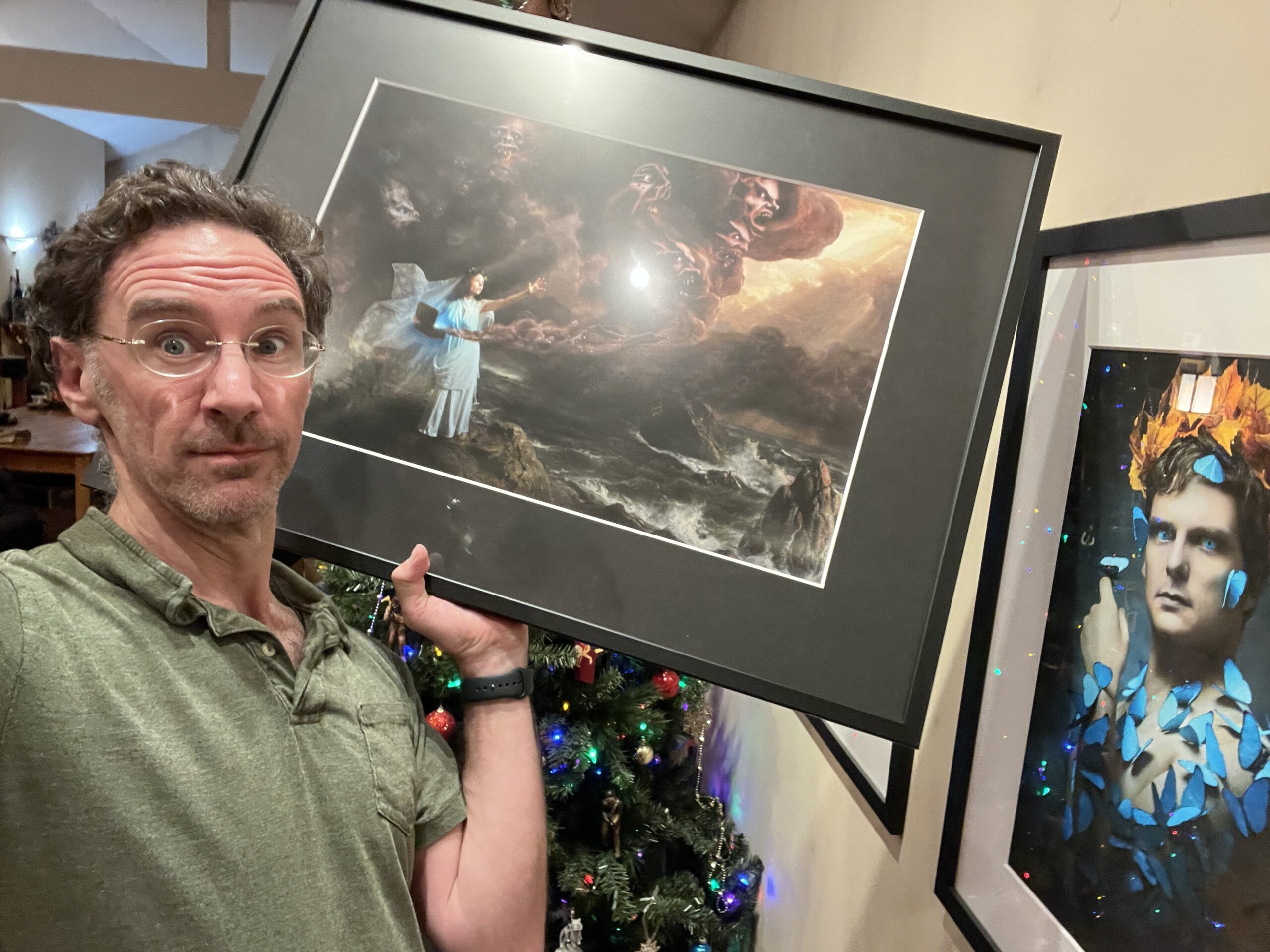
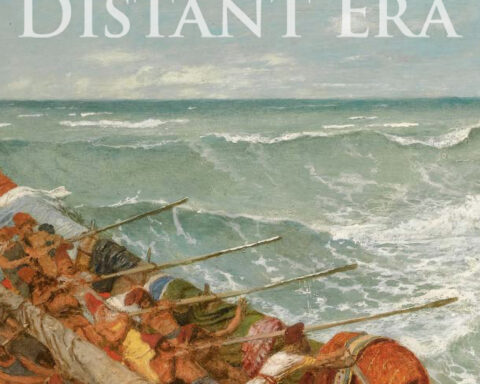
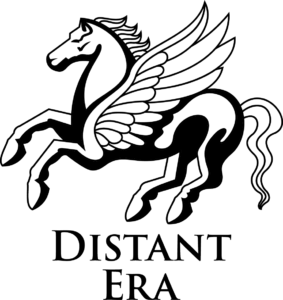
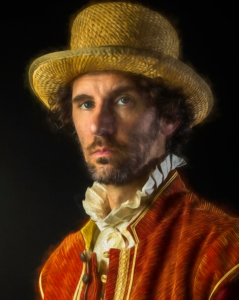

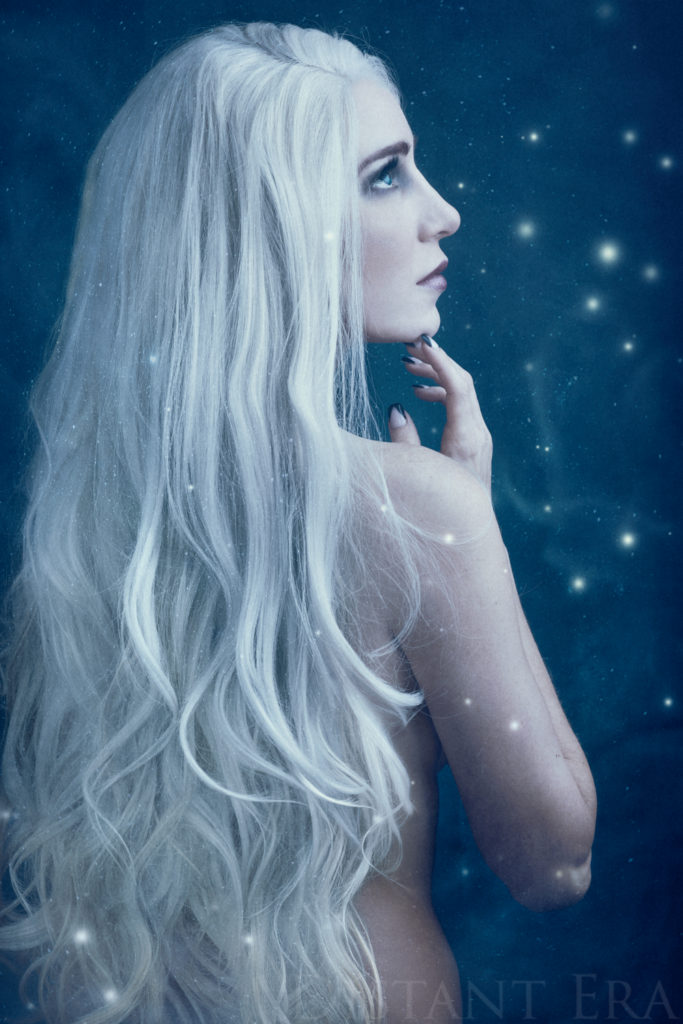
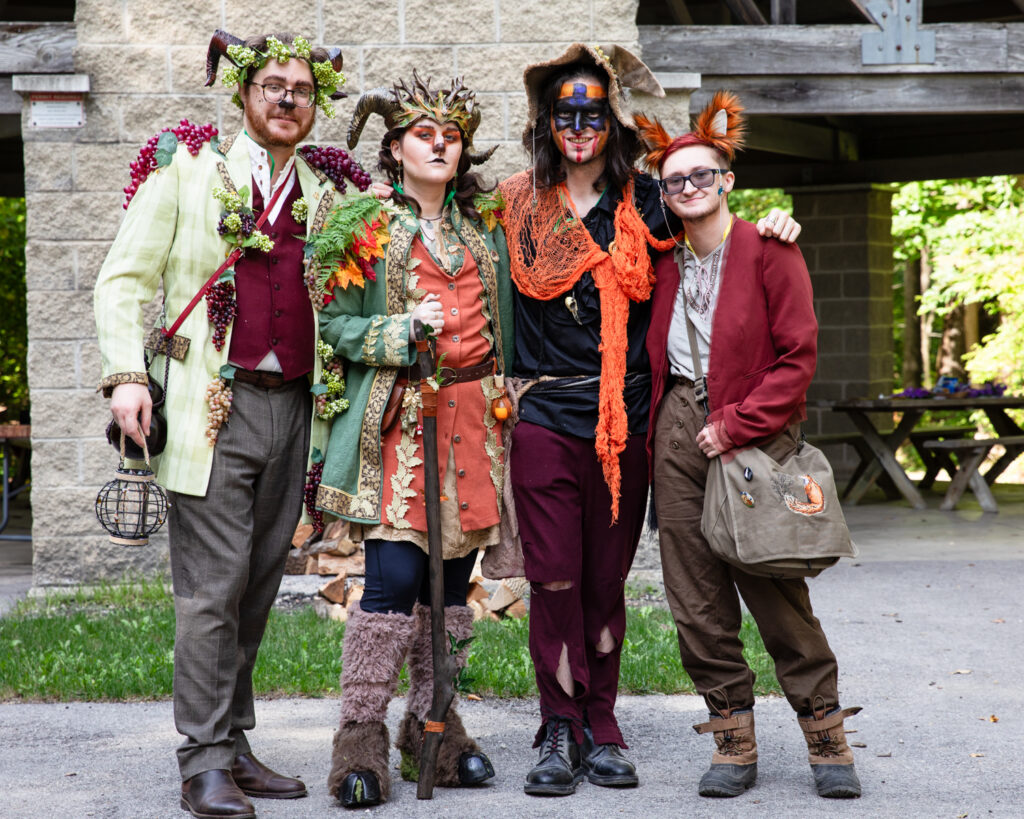
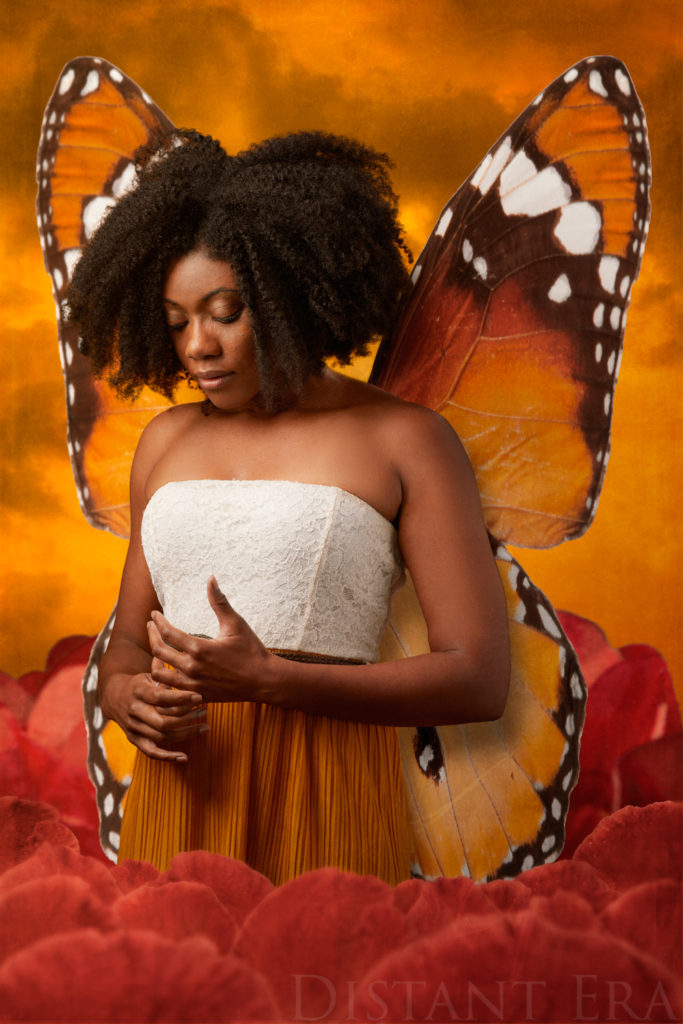


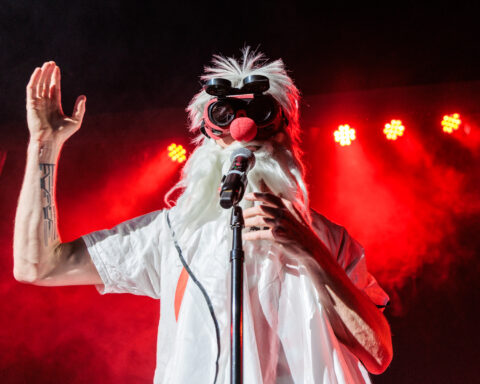
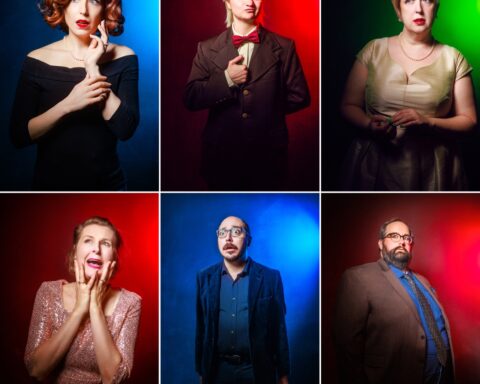
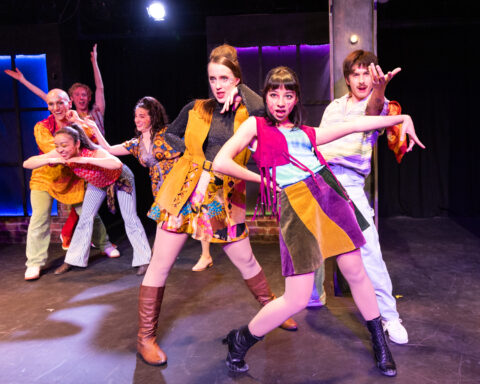


Follow Me